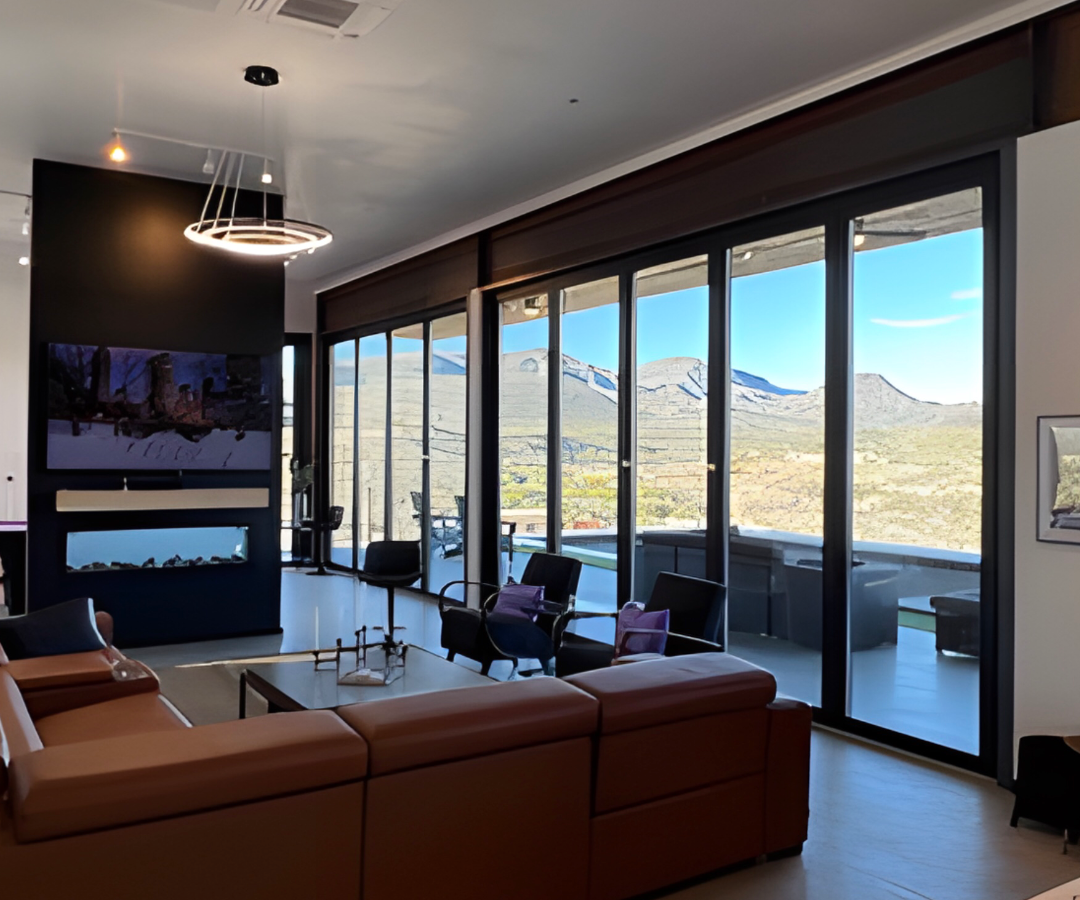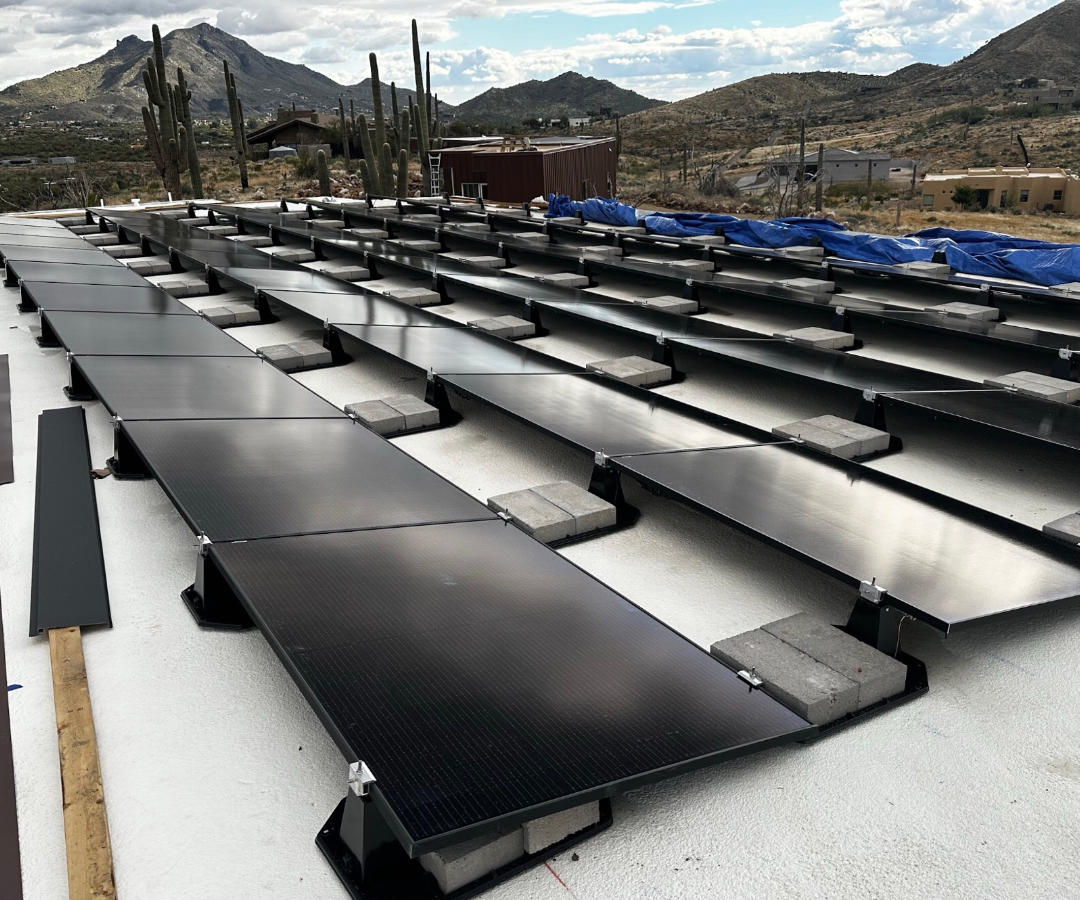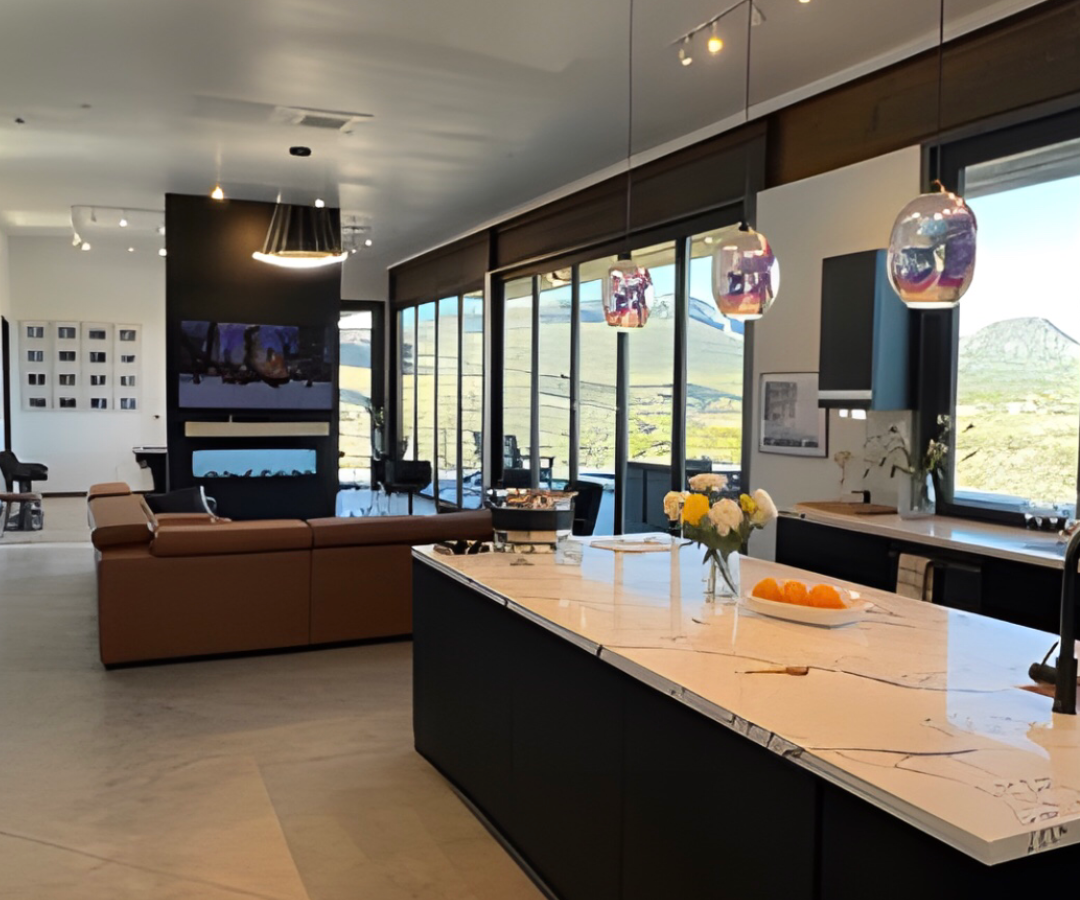By David M. Brown
Mid-century modern architecture. A showcase of sustainable building design, construction, and home products. An eco-friendly, budget-built home in the high desert of Arizona, producing power, capturing and treating water onsite, even growing food — all for a total cost of about $300,000 without the land, low in comparison to other newly constructed luxury homes in the Valley. This self-sufficient home can now be toured, studied, and booked for events and stays.
Constructed on a 5.8-acre parcel in the hills of Cave Creek, the AZ Green House Project includes a 2,950-square-foot main house with a fully equipped kitchen, billiards room, greenhouse dining room, and master suite, as well as a 1,650-square-foot three-bedroom guest house.
The riparian campus is sited 110 feet above the seasonally flowing Cave Creek and provides 360-degree mountain and lush desert views. A few miles away is the historic Lemon Springs Mine, originally worked by a former Confederate soldier and still marked by his cross, and the 2,154-acre Spur Cross Recreation Area.
 Inspiring the project are the Arts & Architecture Magazine-sponsored Case Study homes that appeared in Los Angeles after World War II in the 1950s and 1960s — in particular, Case Study #22, architect Pierre Koenig’s Stahl House, which cantilevers off the Hollywood Hills above Sunset Boulevard, explains Tim Mooney, the Scottsdale-based designer and developer who envisioned the AZ Green House project five years ago.
Inspiring the project are the Arts & Architecture Magazine-sponsored Case Study homes that appeared in Los Angeles after World War II in the 1950s and 1960s — in particular, Case Study #22, architect Pierre Koenig’s Stahl House, which cantilevers off the Hollywood Hills above Sunset Boulevard, explains Tim Mooney, the Scottsdale-based designer and developer who envisioned the AZ Green House project five years ago.
“These homes were designed as models of modernity and affordability 70 years ago, and we’re adding sustainability to this,” Mooney explains. “That’s our vision for the project and our motto, ‘Build Green, Save Green.’” And, we encourage others to follow us as they plan their homes. That’s what we ask about many of the components in this house: ‘Why doesn’t everyone do that?’”
Solar, Septic & HVAC
 The AZ Green House will use significantly less energy than even energy-efficient homes: architectural overhangs, limited windows with a western exposure, Low-E high-efficiency windows and doors, solar power, spray-foam insulation, low-wattage LED lighting, Energy Star®-rated appliances, and high-SEER HVAC equipment. The home will produce more energy than it uses, so Mooney expects to sell the excess to Arizona Public Service, the state’s largest provider of electricity.
The AZ Green House will use significantly less energy than even energy-efficient homes: architectural overhangs, limited windows with a western exposure, Low-E high-efficiency windows and doors, solar power, spray-foam insulation, low-wattage LED lighting, Energy Star®-rated appliances, and high-SEER HVAC equipment. The home will produce more energy than it uses, so Mooney expects to sell the excess to Arizona Public Service, the state’s largest provider of electricity.
Overall, the effort began with passive building design, which limits solar heat gains without sacrificing the panoramic 2,300-foot-high views.
“We’ve taken a light footstep on this unique high-desert land, conserving water and protecting the lush vegetation,” Mooney says. A majority of the parcel will be left undisturbed, including 24 saguaros, some as high as 25 feet and 150-plus years old. “Not one of these desert titans have been disturbed from their habitat,” he adds.
Three major home components are the high-performance HVAC, the solar and zero-discharge septic systems.
Four Mitsubishi Electric Trane HVAC US LLC inverter-based heat pumps, with SEER2 (Seasonal Energy Efficiency Ratio) from 19 to 23 were installed. These high-efficiency outdoor units are connected to quiet electric ceiling cassettes and wall-mounted units. The SEER2 designation represents a recently updated SEER formula. Each of these helped meet unique requirements of the different zones in this home, allowing the systems to operate at lower energy demand, explains Ken Johnson, regional sales manager for the Suwannee, Georgia-based company.
“The ceiling units eliminated the need for large ductwork running through the home. This helps maintain the architectural aesthetics and provides very quiet operation and superior comfort. We also had a couple of small ducted systems that allowed for proper system sizing and the ability to integrate indoor air quality systems as necessary,” he says.
Mitsubishi Electric uses variable capacity “inverter” technology which can perform as much as 40% more efficiently than conventional HVAC systems, adds Johnson. “Importantly, heating with heat pumps can be 200% to 400% more efficient than electric resistance heating or a gas furnace. In this higher-elevation desert home that sees some colder temperatures, that means a significant reduction of winter electric usage.”
The first septic system of its kind installed in Arizona, the space-saving, sustainable NextGen installation involves a three-stage process, including simultaneous biological aerobic and anoxic treatment, membrane separation, and ozone disinfection, explains Rakesh Govind, the company founder and principal. In brief, wastewater enters the first compartment, is aerated with moving biomedia, and then disinfected with ozone.
“The water coming out of our unit is purer than what comes in,” he says.
Neatly installed behind the garage, the system requires no drain field, as conventional systems do. Not only does this reduce possible environmental damage to the ground water, it saves space, he explains. The system results in as much as 1,500 gallons of re-filtered water, which can be used for landscaping, or even fighting a forest fire, such as the one the Cave Creek area experienced a few years ago, he says.
Scottsdale-based iVee League Solar installed the 20-kilowatt solar system, one array of 50 panels, on the rooftop of the main house.
Christopher Yau, its CEO, says, “This innovative project is not just about harnessing solar energy; it’s about showcasing the latest advancements in sustainable living. By providing solar solutions for this innovative initiative, iVee League Solar contributes to a greener future and demonstrates the potential for self-sustainable living.”
Doors to Green & a Full-Service Dining Room
 Among the many other green building components in the AZ Green House are floor-to-ceiling sliding and tilting doors from Panoramic Doors, Laredo, Texas. These are triple-paned and argon gas infused. Cave Creek is about seven to 10 degrees Fahrenheit cooler year round than Scottsdale, but temperatures in the foothills can still exceed 100 degrees in the summer and fall into the 20s during winter nights, Mooney explains.
Among the many other green building components in the AZ Green House are floor-to-ceiling sliding and tilting doors from Panoramic Doors, Laredo, Texas. These are triple-paned and argon gas infused. Cave Creek is about seven to 10 degrees Fahrenheit cooler year round than Scottsdale, but temperatures in the foothills can still exceed 100 degrees in the summer and fall into the 20s during winter nights, Mooney explains.
For potable water, neighbors share and maintain a common well, and the home harvests rainwater and reuses its greywater from sinks for xeriscape landscaping, including the orchard, and edible plants. In addition, the team chose low-flow plumbing fixtures, adding to the energy savings.
New composting and planting techniques will enhance the productivity of the garden and orchard. And the indoor/outdoor dining room incorporates low-water-use aeroponic plant towers growing a variety of greens, herbs, and vegetables such as mint, thyme, snap peas and tomatoes. “That’s farm to table –– in four feet!” he says with a smile. The ceiling is Polycoolite, which allows sun in while reducing heat gain; the floor is cool scored concrete.
The 12,000-gallon saltwater pool has a solar-powered pool cover. “Uncovered pools can lose up to 75 gallons a day in the hot Valley,” Mooney says, “but this one will cut that to about 2%.” He adds that the salt water avoids potentially skin-damaging chemicals, and the cover prevents animal entries and keeps the water warmer, extending the swimming season.
Recycled materials are widely used. These include CorTen steel siding and steel roofing, recycled “blue jean” insulation, the decorative use of low-cost repurposed cargo container doors, recycled furniture, and recycled turf from plastics just outside the pool, which is less expensive than natural turf and newly manufactured artificial products. Lifetime low-maintenance materials include Japanese Shou Sugi Ban burnt cedar siding, metal roofing and concrete flooring.
The eco-friendly interior incorporates low VOCs, zero formaldehyde, limited interior paints, stains, and rugs, with extensive use of natural materials.
Two charities, Habitat for Humanity Central Arizona and United Food Bank of Arizona, have already benefited from 14-days of guided home tours and a 50-person sunset dinner. The charities sold tickets through their support networks, social media outreach, and earned media coverage.
“We are so grateful to be partnering with The Arizona Greenhouse Project, an initiative designed to inspire and educate a new generation of homeowners on the benefits of sustainable living,” says Dusty Parsons, chief marketing officer for Habitat for Humanity Central Arizona.
“With our mission to build strength, stability, and self-reliance through shelter, this partnership aligns perfectly with our vision of creating a more livable and environmentally sustainable Arizona.” Since 1985, the nonprofit has built more than 1,200 homes, completed more than 3,800 repairs and improved living conditions for 5,000-plus Arizona families.
Mooney concludes: “More than anything, we want to provide an example of ‘going-green why-nots.’ Things that just make sense, that bring new technologies, greater efficiencies, and lower costs. If we want people to go greener, we need to make it easier and cheaper. We’ve done that. Others can, too, and with this wonderful home we’re happy to showcase how.”
For more information, see www.azgreenhouseproject.com





